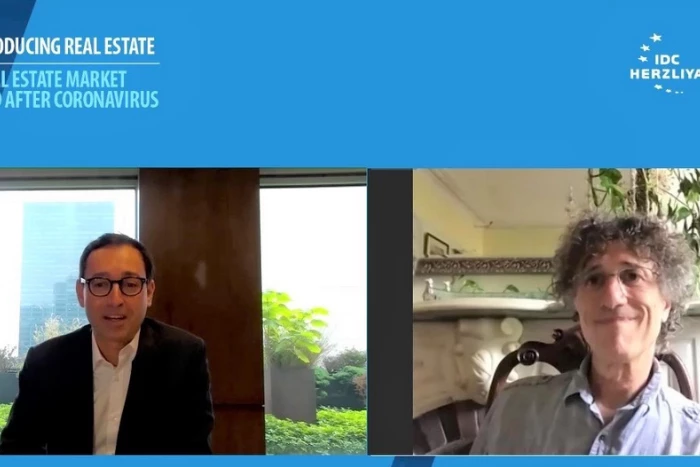
On September 9, 2020, the Gazit-Globe Real Estate Institute at IDC Herzliya held the third session of its Zoom series on income-producing real estate. Participating in the session, which dealt with the American real estate market during and after COVID-19, was Laurent Morali, president of Kushner Companies, and Peter Grant, real estate editor of the Wall Street Journal, who acted as moderator.
The session began with greetings from Prof. Amnon Lehavi, dean of the Harry Radzyner Law School and academic director of the Gazit-Globe Real Estate Institute at Reichman University. Peter Grant, real estate editor of the Wall Street Journal, then conducted an interview with Laurent Morali, president of Kushner Companies.
Kushner is a US real estate firm with $10 billion in assets and over 800 employees. Kushner's diverse portfolio encompasses: residential (over 20,000 apartments), commercial, retail, hospitality, and industrial, with 10.8 million square feet currently under development.
Laurent Morali, Kushner president, who joined the company in 2008, began by comparing the scope of income-producing real estate activity in New York City during the COVID-19 crisis to that during the financial crisis of 2008. According to him, the scope of income-producing real estate activity in New York City (leases above the 100,000 square foot mark) between the months of March and August 2020 was higher than the volume of activity in the corresponding period in 2008 and 2009.
Morali believes that New York City has remained attractive for investment even during the COVID period. He believes that, as in previous crises, New York has the ability to reinvent itself and that the leading industries operating in the city (finance, high-tech, media, etc.) will help it recover from the crisis, so that even if there is a decline in the activity of a particular industry, it will be balanced by an increase in activity in another industry.
Asked by Grant whether the transition to working from home and the announcement by technology companies that they would not be returning to the office in the coming months would have a long-term effect on the demand for office space, Morali replied that even companies that have adopted a flexible work model employ workers in their offices, and at this stage have not declared any intention of leaving New York City. Moreover, he says that the rate of contract renewals throughout this period has been high compared to the corresponding period last year, and that the assumption is that this is a temporary problem that will end with the discovery of a vaccine. In his estimation, when the universities reopen in New York City, there will be a return to the city and supply and demand will be balanced.
Morali went on to say that the coronavirus crisis has had a differential effect on the various sectors of income-producing real estate. While the shopping center sector has suffered severe damage, the multifamily sector has not been affected. In fact, the multifamily sector, which is at the core of the company's activities, is actually experiencing a boom in the suburbs. For example, the exit of many New York City residents during the COVID period increased the demand for multifamily housing in the suburbs, with the company's multifamily complexes in New Jersey now fully occupied. He further noted that although the prices of multifamily housing in the suburbs did not decrease during COVID, financing costs have. In light of this, the company identified an opportunity in the multifamily area and purchased 1,500 apartments between April and September 2020.
However, Morali noted that a distinction should be made between multifamily in the suburbs and multifamily in urban areas. Whereas occupancy in the suburbs during the COVID period rose, occupancy in New York City experienced a marked decline, with vacancy rates ranging from 15% to 20%. According to him, on the one hand, this period offers an opportunity to purchase multifamily properties in the city, but on the other hand, there are few properties for sale, as the property owners believe that this is only a temporary imbalance between supply and demand, which will pass with the end of the COVID-19 crisis. Another challenge facing the multifamily sector in New York City is the regulatory restrictions that were imposed on rental housing in the city in 2019 that affect mainly rent-stabilized units. However, Morali believes that for companies operating with a long-term view, which are able to cope with the regulatory constraints and the temporary decline in occupancy in the coming year, this period is an opportunity to purchase multifamily properties at the appropriate prices.
Morali went on to say that he hopes that the upcoming New York City elections in November 2021 will lead to a change and to regulatory measures that will encourage business activity in the city. In his opinion, even now, the regulators understand that they have gone too far with some of the measures they have taken, such as housing the homeless in hotels in the city during the lockdown – a decision from which they are now retreating.
Finally, Morali estimated that in the next six months, there will be opportunities to purchase assets below market price, and that the volume of transactions will increase.
To watch the session on the Gazit-Globe Real Estate Institute’s Facebook page, click here >>



